论基于4ps理论的A公司市场营销策略-毕业论文
浅析市场营销4p理论策略的论文
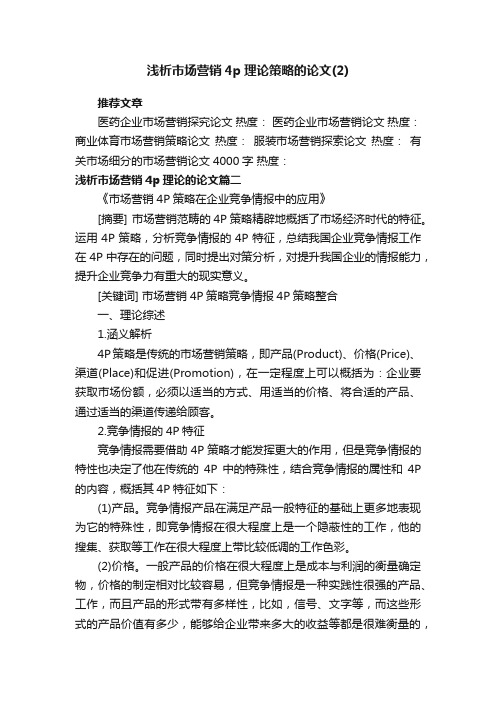
浅析市场营销4p理论策略的论文(2)推荐文章医药企业市场营销探究论文热度:医药企业市场营销论文热度:商业体育市场营销策略论文热度:服装市场营销探索论文热度:有关市场细分的市场营销论文4000字热度:浅析市场营销4p理论的论文篇二《市场营销4P策略在企业竞争情报中的应用》[摘要] 市场营销范畴的4P策略精辟地概括了市场经济时代的特征。
运用4P策略,分析竞争情报的4P特征,总结我国企业竞争情报工作在4P中存在的问题,同时提出对策分析,对提升我国企业的情报能力,提升企业竞争力有重大的现实意义。
[关键词] 市场营销4P策略竞争情报4P策略整合一、理论综述1.涵义解析4P策略是传统的市场营销策略,即产品(Product)、价格(Price)、渠道(Place)和促进(Promotion),在一定程度上可以概括为:企业要获取市场份额,必须以适当的方式、用适当的价格、将合适的产品、通过适当的渠道传递给顾客。
2.竞争情报的4P特征竞争情报需要借助4P策略才能发挥更大的作用,但是竞争情报的特性也决定了他在传统的4P中的特殊性,结合竞争情报的属性和4P 的内容,概括其4P特征如下:(1)产品。
竞争情报产品在满足产品一般特征的基础上更多地表现为它的特殊性,即竞争情报在很大程度上是一个隐蔽性的工作,他的搜集、获取等工作在很大程度上带比较低调的工作色彩。
(2)价格。
一般产品的价格在很大程度上是成本与利润的衡量确定物,价格的制定相对比较容易,但竞争情报是一种实践性很强的产品、工作,而且产品的形式带有多样性,比如,信号、文字等,而这些形式的产品价值有多少,能够给企业带来多大的收益等都是很难衡量的,很难找到参照物,因此,价格难以衡量。
(3)渠道。
传统产品的渠道主要是产品从厂商传递给顾客的一个过程。
情报产品具有隐蔽性和对抗性,他的顾客可能是单一的,他的传递需要采取隐蔽的手段,因此在很大程度上多采用“单一渠道”、“零级渠道”,即渠道的传递过程中只有制造商和顾客。
腾讯公司的营销策略分析-毕业论文
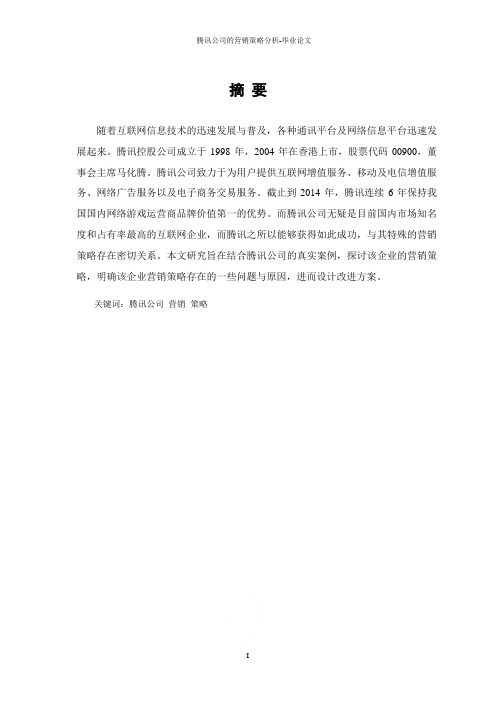
摘要随着互联网信息技术的迅速发展与普及,各种通讯平台及网络信息平台迅速发展起来。
腾讯控股公司成立于1998年,2004年在香港上市,股票代码00900,董事会主席马化腾。
腾讯公司致力于为用户提供互联网增值服务、移动及电信增值服务、网络广告服务以及电子商务交易服务。
截止到2014年,腾讯连续6年保持我国国内网络游戏运营商品牌价值第一的优势。
而腾讯公司无疑是目前国内市场知名度和占有率最高的互联网企业,而腾讯之所以能够获得如此成功,与其特殊的营销策略存在密切关系。
本文研究旨在结合腾讯公司的真实案例,探讨该企业的营销策略,明确该企业营销策略存在的一些问题与原因,进而设计改进方案。
关键词:腾讯公司营销策略AbstractWith the rapid development of information technology and the popularization of the Internet, a variety of network communications platform and information platform developed rapidly. Tencent Holdings, Inc. was founded in 1998, 2004, listed in Hong Kong stock code 00900, Chairman of the Board Ma. The company is committed to provide users with Tencent Internet value-added services, mobile and telecommunications value-added services, online advertising and e-commerce transaction services. As of 2014, Tencent six consecutive years to maintain the value of the first advantages of China's domestic online game operators brand. And Tencent is undoubtedly the highest domestic market visibility and market share of Internet companies, Tencent has been able to achieve such success, there is a close relationship with its special marketing strategy. This paper aims to combine real cases Tencent to discuss the company's marketing strategy, a clear cause of the problems associated with the presence of corporate marketing strategy, and then design improvements.KEYWORDS:marketing strategy Tencent目录摘要 (I)Abstract (II)目录 (III)引言 (1)一、理论概述 (2)二、腾讯营销策略现状 (3)(一)企业介绍 (3)(二)营销策略 (3)1.产品策略 (3)2.价格策略 (4)3.渠道策略 (4)4.促销策略 (5)三、腾讯营销策略的局限性与改进方案 (8)(一)腾讯营销环境SWOT分析 (8)(二)腾讯营销策略改进建议 (10)1.强化创新,丰富产品策略 (10)2.拓展青年客户市场 (11)3.提升渠道战略合作 (11)4.提升品牌知名度与系统安全性 (11)参考文献 (13)引言随着互联网信息技术的迅速发展与普及,各种通讯平台及网络信息平台迅速发展起来。
A公司市场营销策略分析

第三节STP市场定位理论
STP是市场细分(segmentation)、目标市场选择(targeting)和市场定位
(positioning)---个词的首写字母的组合。
STP理论的根本要义在于选择确定目标消费者或客户,或称市场定位理论。 根据STP理论,市场是一个综合体,是多层次、多元化的消费需求集合体,任 何企业都无法满足所有的需求,企业应该根据不同需求、购买力等因素把市场分 为由相似需求构成的消费群,即若干子市场。这就是市场细分。 STP理论的第一步是市场细分。所谓市场细分就是把市场细分为具有不同需 要、特点或彳亍为的购买者群体,并针对每个购买者群体采取单独的产品或市场营 销组合战略①。STP理论的第二步是目标市场选择。市场细分后,企业要对各类 细分市场进行评估,并根据细分市场的吸引力和本企业的资源和目标确定一个或 几个细分市场作为目标市场。STP理论的第三步是市场定位。所谓市场定位就是
as
close communication with customers.This paper will provide
a
people in the same trade with c¨stomers'demands.
out and satisfy learning experience of how to dig
concept)认为:消费者会喜欢那些随处可买到的价格低廉的产品,因此管理部门 应该把注意力集中在改进生产和销售效率方面。产品观念(product concept)认为消 费者喜欢那些质量最优、性能最好和特色最多的产品,因此企业应该致力于对产
品不断地进行改进。推销观念(selling concept),这种观念认为除非机构采用大规 模的推销和促销活动,否则消费者不会购买。市场营销观念(marketing concept)
4ps营销策略

4ps营销策略4P营销策略是指产品、价格、渠道和促销四个方面的营销活动,也被认为是营销组合的基本元素。
下面是一个关于4P营销策略的700字的例子。
产品(Product):产品是企业提供给消费者的实质性产品或服务。
在产品方面的营销策略主要包括产品定位、产品特性、产品品质和产品创新等方面。
企业应该根据目标市场的需求和竞争对手的分析,确定产品定位。
同时,产品要具有一定的特性和优势,以吸引消费者的注意。
另外,企业应该注重产品的品质控制,确保产品的可靠性和性能。
最后,企业应该不断进行产品创新,加入新的技术和功能,以满足市场的需求。
价格(Price):价格是指企业向消费者销售产品或服务所收取的费用。
在价格方面的营销策略主要包括定价策略、定价方法和定价策略的实施等方面。
企业应该根据市场需求和竞争对手的定价情况,确定适当的定价策略。
企业可以采用市场定价、成本定价或竞争定价等方法来确定产品的价格。
最后,企业应该根据定价策略的实施情况,对价格进行调整,以提高产品的竞争力。
渠道(Place):渠道是指产品从生产者到消费者的流通渠道。
在渠道方面的营销策略主要包括渠道选择、渠道设计和渠道管理等方面。
企业应该根据产品的特点和目标市场的需求,选择合适的渠道。
同时,企业应该设计一个高效的渠道系统,以确保产品能够及时地到达消费者。
另外,企业应该对渠道进行有效的管理,以提高渠道的效益和竞争力。
促销(Promotion):促销是指企业通过广告、销售推广和公关等手段来促进产品销售的活动。
在促销方面的营销策略主要包括广告策略、销售推广策略和公关策略等方面。
企业应该通过广告来传达产品的信息和优势,吸引消费者的购买。
同时,企业应该通过销售推广手段来促进产品销售,如促销活动、赠品和优惠券等。
另外,企业应该进行公关活动,与媒体和消费者建立良好的关系,树立企业的形象。
总之,4P营销策略是企业进行市场营销活动的基本框架,通过产品、价格、渠道和促销四个方面的综合策略,提高企业的竞争力和市场份额。
基于4ps理论李宁在美国市场营销策略分析

Manuela Ingaldi、Katarína Lestyánszka Škůrková(2015)主要分析了体育运动品牌在国际市场营销过程中定价策略的影响因素,比如店铺位置、品牌价值大小、价值链有效性、竞争者实力等。George J. Avlonitis(2016)提出4ps分析的使用渗透到了各个方面中的文献研究中,其中便以Nike这一服装品牌为例,研究侧重于为企业分析可供推荐的营销战略行动。学者Otília Zorkóciová和 Erika Mária Jamborová(2016)对全球六大体育服装品牌进行了对比研究,包括Nike,Reebok,Adidas等在内,对21世纪全球体育服装用品市场营销发展前景进行了前瞻性预测。比如学者Adel I. El-Ansary(2016)就现在的全球经济大环境为背景,认为服装企业的营销战略得与外部环境匹配,从市场定位、产品类型、价格制定以及促销手段上都得运用差异化策略,对应不同的服装市场需求。
通过中外学者的研究对比,最终发现中国品牌在国际道路上还存在以下几个问题:第一,中国市场营销理论相较于国外起步晚,没有形成一定的体系,同时在这一专业方面的学者对4PS理论的觉悟也比外国起步晚,导致我国理论体系的落后。第二,中国缺少标志性品牌,在统计数据中,500强中国排名第一的企业是国家电网,第二是腾讯。这些品牌本身就具有很深的市场价值并不能成为例如李宁这类服装品牌的标榜,这一点也使得转件的研究具有局限性。这篇文章选取李宁这一品牌为例,分析在当今国际品牌竞争压力之下,李宁是怎样脱离困境,为我国的体育民族品牌做出好的榜样,并希望能够为同类型的困境企业提供相应脱离财务困境的启发和建议。
1ቤተ መጻሕፍቲ ባይዱ2 研究理论及方法
本文主要采用文献综述法和调查法,通过4PS理论对李宁在美国市场的营销策略进行分析。
4Ps营销策略组合的角度分析中小企业营销

4Ps营销策略组合的角度分析中小企业营销TITLE 1: PRODUCTProduct is the first and the most fundamental element of the 4Ps marketing strategy. It refers to the goods or services that a company offers to the customers for purchase. In the context of small and medium-sized enterprises (SMEs), product development is one of the most significant challenges faced by the entrepreneurs. This paper focuses on analyzing the product-related marketing strategies of SMEs and their role in the success of the business.Firstly, SMEs need to identify the market demand and analyze the customer preferences before developing the product. Conducting market research can help the entrepreneur identify the gap in the existing products in the market and accordingly develop the unique selling proposition (USP) of the product. SMEs need to concentrate on the quality of the product that sets them apart from their competitors. The product should not only meet the customer expectations but should also exceed them to build long-lasting relationships with the customers.Secondly, product differentiation can also be an effective marketing strategy for SMEs. By offering a unique product, SMEs can attract customers who want something different from the existing products in the market. However, product differentiation should not undermine the quality and the functionality of the product. The entrepreneur should also focus on creating a memorable brand image for the product that resonates with the customers.Thirdly, the pricing of the product can also impact the success of SMEs. SMEs need to do a cost-benefit analysis to determine an optimal price range that can yield maximum profits for the business. Pricing strategies such as dynamic pricing, psychological pricing, and bundling can also help in increasing sales and revenue.Fourthly, promotion is another crucial aspect of marketing the product of SMEs. The entrepreneur needs to strategize the promotional campaigns to reach the target audience effectively. The promotional campaigns should aim at emphasizing the USP of the product and creating a buzz around the product. Social media platforms, email marketing, influencer marketing, and offline advertising can all be effective promotion channels.In conclusion, the product is the backbone of any business, and SMEs need to develop their product keeping in mind the customer demand, quality, and differentiation to succeed in the market. The four strategies mentioned above – quality, differentiation, pricing, and promotion – are interdependent and need to be approached strategically to achieve the desired results.TITLE 2: PRICEPrice is the second element of the 4Ps marketing strategy. It refers to the cost that the customers need to pay to avail the goods or services offered by the SMEs. For SMEs, pricing is a challenging task as they need to balance profitability while attracting customers to the business. This paper analyzes the pricing strategies adopted by SMEs and their role in the success of the business.Firstly, SMEs need to determine the cost of producing the product or service. The entrepreneur should include not only the direct costs but also the indirect costs such as rent, salaries, and taxes while calculating the cost of the product. This will help in determining the minimum price required to cover the costs and yield the desired profit margin.Secondly, SMEs can adopt a cost-based pricing strategy that factors in the production cost, desired profit margin, and the prevailing market rate. This strategy can ensure that the price of the product reflects the value that the customers associate with the product. However, this strategy needs to be adopted strategically to ensure that the price of the product is competitive in the market.Thirdly, value-based pricing is another effective strategy adopted by SMEs. This strategy is ideal for SMEs that offer unique and high-quality products or services. The price is determined based on the value that the product or service offers to the customers. The entrepreneur can charge a premium price if the product or service fulfills the customer requirements in a unique way.Fourthly, dynamic pricing is a strategy adopted by SMEs that sell products or services that have high demand fluctuations. The price of the product is adjusted based on the time of purchase, demand, and availability of the product or service. This strategy can help SMEs maximize their profits while ensuring that the price stays competitive in the market.To conclude, pricing is a sensitive matter, and SMEs need to adopt effective pricing strategies that factor in the cost, value, demand,and competition to succeed in the market. The entrepreneur needs to assess the market trend and customer demand to adopt the pricing strategy that yields maximum profits and customer loyalty.TITLE 3: PROMOTIONPromotion is the third element of the 4Ps marketing strategy. It refers to the communication strategy adopted by SMEs to create awareness and interest in their products or services. For SMEs, promotion is a crucial aspect of their marketing strategy as it helps in reaching their target audience effectively. This paper analyzes the promotional strategies adopted by SMEs and their role in the success of the business.Firstly, SMEs need to identify their target audience and their preferences before developing a promotional strategy. The entrepreneur can use online and offline tools such as surveys, social media platforms, and focus groups to identify the audience and tailor the promotional campaign accordingly.Secondly, the promotional campaign should focus on the unique selling proposition (USP) of the product or service that sets it apart from its competitors. The entrepreneur should highlight the benefits of the product or service that resonate with the customer needs and preferences. The promotional campaign should aim to create an emotional connection with the customers that inspires them to make a purchase.Thirdly, the promotional campaign should be designed to suit the budget, time frame, and nature of the product or service. Theentrepreneur can use a mix of promotional channels such as social media platforms, email marketing, influencer marketing, and offline advertising to reach the target audience effectively.Fourthly, the promotional campaign should also aim to create a memorable brand image for the product or service. The entrepreneur can use multimedia elements such as visuals, testimonials, and storytelling to create a brand image that resonates with the customers. The branding should aim to create a perception of quality, trust, and reliability.In conclusion, promotion is a crucial aspect of SMEs' marketing strategy, and the promotional campaign should be tailored to the target audience, product, and budget. The promotional channels, branding, and messaging should aim to create emotional connections with the customers that inspire them to make a purchase and build long-lasting relationships.TITLE 4: PLACEPlace is the fourth element of the 4Ps marketing strategy. It refers to the distribution channels adopted by SMEs to make their products or services available to the customers. For SMEs, place is a critical aspect of their marketing strategy as it helps in reaching the target audience effectively. This paper analyzes the distribution strategies adopted by SMEs and their role in the success of the business.Firstly, SMEs need to determine the best distribution channel that suits their product or service. The entrepreneur can choose from arange of channels such as direct selling, retail stores, e-commerce, and wholesale dealers. The choice of the channel should depend on the nature of the product or service, target audience, and the entrepreneur's budget.Secondly, SMEs can adopt a multichannel distribution strategy that uses a combination of distribution channels. This strategy can help SMEs reach a wider audience and improve their brand visibility. However, the entrepreneur needs to ensure that the distribution channels are integrated and do not cannibalize each other's sales.Thirdly, SMEs should also ensure the availability of the product or service in the chosen distribution channel. The entrepreneur needs to ensure that the product is easily accessible and available to the customers. The product should be distributed to the channels based on the customer demand and the channel's reach.Fourthly, SMEs need to ensure the quality of the product or service during the distribution process. The entrepreneur needs to ensure that the product is handled and transported correctly and reaches the customers without any damage or deterioration in quality.In conclusion, place is a critical aspect of SMEs' marketing strategy, and the distribution channels should be selected based on the nature of the product or service, target audience, and availability. The distribution channels should aim to improve brand visibility and ensure the availability and quality of the product or service.TITLE 5: PRODUCTIVITYProductivity is a critical aspect of the success of SMEs. It refers to the efficiency and effectiveness of the business process and the ability of the business to optimize resource utilization. In the context of marketing, productivity can play a significant role in enhancing the profitability and the customer satisfaction of SMEs. This paper analyzes the role of productivity in SMEs' marketing strategy and its impact on the business's success.Firstly, SMEs need to optimize their production process to ensure maximum efficiency and effectiveness. The entrepreneur needs to ensure that the production process is streamlined and that the resources are optimized to minimize the cost per unit. The production process should aim to deliver the product or service within the stipulated time frame to meet the customer demand.Secondly, productivity can also be enhanced by automating the business processes. The entrepreneur can use technology tools such as customer relationship management (CRM), inventory management software, and automated customer service to optimize the resource utilization and ensure maximum efficiency.Thirdly, productivity can also be enhanced by investing in the training and development of the workforce. The entrepreneur needs to ensure that the workforce is trained to use the technology tools, and the skills required to provide quality customer service are imparted.Fourthly, productivity can be enhanced by adopting a performance measurement system that tracks the performance of the businessprocess and provides actionable insights to improve efficiency. The entrepreneur should regularly monitor the performance of the marketing strategies and make modifications to improve effectiveness and profitability.In conclusion, productivity is a significant factor that can play a critical role in the success of SMEs' marketing. The entrepreneur needs to optimize the production process, automate the business process, train the workforce, and adopt a performance measurement system to ensure maximum efficiency and effectiveness.TITLE 6: PEOPLEPeople refer to the customers, employees, and stakeholders of the SMEs. In the context of marketing, people play a significant role in building the brand image, creating loyalty, and enhancing the profitability of the business. This paper analyzes the role of people in SMEs' marketing strategy and their impact on the business's success.Firstly, SMEs need to understand the customer needs and preferences to develop a marketing strategy that resonates with the customers. The entrepreneur should develop a customer-centric marketing approach that prioritizes customer satisfaction and loyalty. The marketing strategy should aim to build an emotional connection with the customers that inspire them to make the purchase and recommend the product or service.Secondly, the employees of the SMEs play a crucial role indelivering quality customer service and building the brand image. The entrepreneur should invest in the training and development of the employees to develop the skills required to provide quality customer service. The employees should be motivated and incentivized to provide the best possible experience to the customers.Thirdly, stakeholders such as suppliers, partners, and investors can also impact the success of the SMEs' marketing. The entrepreneur needs to maintain a healthy relationship with the stakeholders and ensure that they are aligned with the business's vision and goals. The entrepreneur should also communicate the marketing strategy and its implications on the stakeholders to develop a common understanding.Fourthly, the entrepreneur should also leverage the loyal customers to enhance the brand visibility and attract new customers. The loyal customers can provide testimonials, feedback, and referrals that can be used in the promotional campaigns and improve the product or service based on the customer feedback.In conclusion, people are a critical aspect of SMEs' marketing strategy and play a significant role in enhancing the profitability and customer satisfaction. The customer-centric approach, employee training and motivation, stakeholder management, and customer loyalty can impact the success of the SMEs' marketing strategy.TITLE 7: POWERPower refers to the ability of the SMEs to influence the market and the competition. In the context of marketing, power can play a significant role in developing a competitive advantage and enhancing the profitability of the business. This paper analyzes the role of power in SMEs' marketing strategy and their impact on the business's success.Firstly, SMEs need to identify their sources of power, such as the quality of the product or service, unique selling proposition, customer loyalty, and market share, to develop a marketing strategy that covers the competitive advantage. The entrepreneur should use the sources of power to develop a unique marketing approach that sets the business apart from its competitors.Secondly, SMEs can leverage the power of partnerships to enhance their market share and reach a wider audience. The entrepreneur can develop partnerships with other businesses, influencers, and media platforms to improve the brand visibility and reach the target audience effectively.Thirdly, SMEs can adopt a proactive approach to market research and competitive analysis to remain relevant and competitive in the market. The entrepreneur should constantly monitor the market trends, customer preferences, and competition to adapt to the changing environment and maintain the competitive edge. Fourthly, SMEs can also leverage the power of innovation to develop new products or services, improve the existing ones, and create a unique selling proposition. The entrepreneur should encourage creativity and innovation among the workforce andinvest in research and development to improve the business's competitiveness.In conclusion, power is a significant factor that can impact the success of SMEs' marketing strategy. The entrepreneur needs to identify the sources of power, develop partnerships, monitor the competition, and invest in research and development to ensure maximum competitiveness and profitability.GRADUATION SUMMARY:The 4Ps marketing strategy – Product, Price, Promotion, and Place – is a fundamental concept that SMEs need to master to succeed in the market. The marketing strategies adopted by SMEs should be tailored to the nature of the product or service, the target audience, and the business's budget to enhance the profitability and customer satisfaction. The seven titles – Product, Price, Promotion, Place, Productivity, People, and Power – analyzed the different aspects of SMEs' marketing strategies and their impact on the business's success. The entrepreneur needs to adopt a holistic approach that integrates these elements and focuses on innovation, customer satisfaction, and competitiveness to achieve the desired results. The role of the graduation supervisor is to guide the students to develop a comprehensive understanding of the 4Ps marketing strategy and its relevance to the SMEs' success. The graduation supervisor needs to provide practical insights, resources, and mentorship to help the students develop effective marketing strategies and succeed in their business ventures.。
毕业论文---蒙牛乳业集团的市场营销战略分析

毕业论文--—蒙牛乳业集团的市场营销战略分析成都东软信息技术职业学院毕业论文题目:蒙牛乳业集团市场营销战略分析作者姓名: 学号:专业班级:指导教师:毕业论文———蒙牛乳业集团市场营销战略分析【摘要】短短10年时间,蒙牛乳业集团的主营业务收入在全国乳制品企业中的排名由第1116位上升至第2位。
其中,UHT牛奶销量居全球第一,液态奶销量居全国第一,冰淇淋销量居全国第一。
蒙牛集团在市场营销方面,有着它独特而值得借鉴的一面。
本文结合理论与事例,共分五个部分论述蒙牛企业的4P框架。
第一部分主要从蒙牛的产品策略方面入手,分析蒙牛的核心产品差异化和产品线拓展。
第二部分研究蒙牛的定价策略,指出蒙牛在产品定价方面的高超之处。
第三部分研究蒙牛的渠道策略。
第四方面分析蒙牛的促销策略,特别是事件营销,其影响力在国内甚至于国外来说,都是空前的。
在最后一部分,从蒙牛的诸多经验中,总结出了几点启示,希望能给国内企业提供一些参考。
【关键词】产品策略定价策略渠道策略促销策略事件营销2毕业论文-——蒙牛乳业集团市场营销战略分析目录前言第一章导论1(1 蒙牛公司简介1(2 市场营销中的4PS概念第二章蒙牛公司的产品策略 2.1蒙牛公司的核心产品分析 2.2蒙牛公司的延伸产品分析第三章蒙牛公司的价格策略 3(1 蒙牛公司的定价策略3(2 消费者的成本分析第四章蒙牛公司的渠道策略 4(1市场营销渠道理论4(2 蒙牛公司的渠道策略第五章蒙牛公司的促销策略 5。
1 促销的概念与作用5.2 蒙牛公司的事件促销第六章蒙牛公司的成功给国内公司营销带来的启示6.1 产品必须具有差异化特征 6。
2 适宜、合理地进行产品线拓展 6。
3 事件营销打造品牌记忆6.4 蒙牛愿景致谢参考文献前言3毕业论文-—-蒙牛乳业集团市场营销战略分析在竞争激烈的市场上,企业的市场营销不仅要开发品质优良的产品、选择有利销售的渠道,制定合理优惠的价格,还必须让顾客及时地了解企业本身及产品,激发其购买欲望,影响其消费行为,扩大企业产品的销售。
欧莱雅公司在中国的市场营销策略研究——基于4P理论的分析
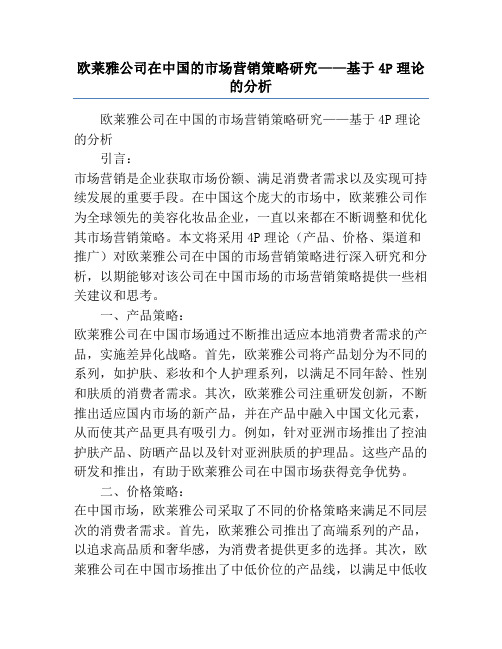
欧莱雅公司在中国的市场营销策略研究——基于4P理论的分析欧莱雅公司在中国的市场营销策略研究——基于4P理论的分析引言:市场营销是企业获取市场份额、满足消费者需求以及实现可持续发展的重要手段。
在中国这个庞大的市场中,欧莱雅公司作为全球领先的美容化妆品企业,一直以来都在不断调整和优化其市场营销策略。
本文将采用4P理论(产品、价格、渠道和推广)对欧莱雅公司在中国的市场营销策略进行深入研究和分析,以期能够对该公司在中国市场的市场营销策略提供一些相关建议和思考。
一、产品策略:欧莱雅公司在中国市场通过不断推出适应本地消费者需求的产品,实施差异化战略。
首先,欧莱雅公司将产品划分为不同的系列,如护肤、彩妆和个人护理系列,以满足不同年龄、性别和肤质的消费者需求。
其次,欧莱雅公司注重研发创新,不断推出适应国内市场的新产品,并在产品中融入中国文化元素,从而使其产品更具有吸引力。
例如,针对亚洲市场推出了控油护肤产品、防晒产品以及针对亚洲肤质的护理品。
这些产品的研发和推出,有助于欧莱雅公司在中国市场获得竞争优势。
二、价格策略:在中国市场,欧莱雅公司采取了不同的价格策略来满足不同层次的消费者需求。
首先,欧莱雅公司推出了高端系列的产品,以追求高品质和奢华感,为消费者提供更多的选择。
其次,欧莱雅公司在中国市场推出了中低价位的产品线,以满足中低收入人群的需求。
这种多价格带的策略,使得欧莱雅公司能够覆盖更广泛的消费群体,进一步拓展其市场份额。
三、渠道策略:欧莱雅公司在中国市场采用多元化的渠道策略,以便更好地将产品推向市场,并满足消费者的购买需求。
首先,欧莱雅公司通过与大型超市、百货商场等合作,将产品销售到线下实体渠道。
其次,欧莱雅公司注重线上渠道的拓展,通过与电商平台合作,提高产品的可及性和便捷性。
此外,欧莱雅公司还在一些一二线城市设立了专卖店,提供更直接和个性化的销售与咨询服务。
通过多种渠道的组合,欧莱雅公司能够更好地触达消费者,并提供更好的购物体验。
【基于4P理论的国际化妆品牌中国市场营销策略分析3800字】
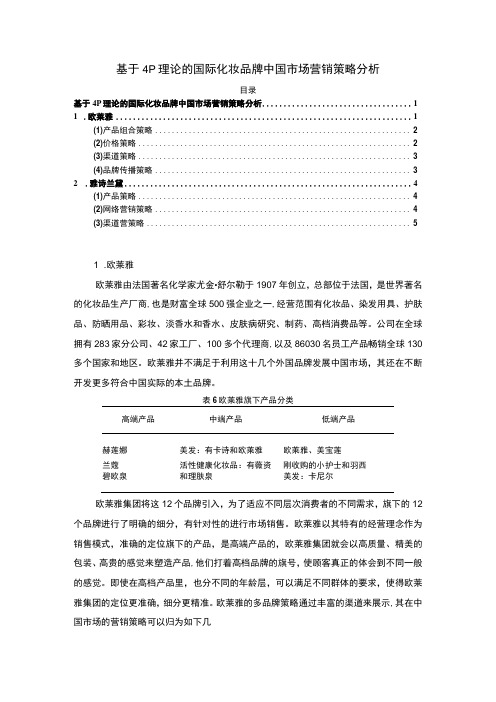
基于4P理论的国际化妆品牌中国市场营销策略分析目录基于4P理论的国际化妆品牌中国市场营销策略分析 (1)1.欧莱雅 (1)(1)产品组合策略 (2)(2)价格策略 (2)(3)渠道策略 (3)(4)品牌传播策略 (3)2.雅诗兰黛 (4)(1)产品策略 (4)(2)网络营销策略 (4)(3)渠道营策略 (5)1 .欧莱雅欧莱雅由法国著名化学家尤金•舒尔勒于1907年创立,总部位于法国,是世界著名的化妆品生产厂商,也是财富全球500强企业之一,经营范围有化妆品、染发用具、护肤品、防晒用品、彩妆、淡香水和香水、皮肤病研究、制药、高档消费品等。
公司在全球拥有283家分公司、42家工厂、100多个代理商,以及86030名员工产品畅销全球130多个国家和地区。
欧莱雅并不满足于利用这十几个外国品牌发展中国市场,其还在不断开发更多符合中国实际的本土品牌。
表6欧莱雅旗下产品分类高端产品中端产品低端产品赫莲娜美发:有卡诗和欧莱雅欧莱雅、美宝莲兰蔻活性健康化妆品:有薇资刚收购的小护士和羽西碧欧泉和理肤泉美发:卡尼尔欧莱雅集团将这12个品牌引入,为了适应不同层次消费者的不同需求,旗下的12个品牌进行了明确的细分,有针对性的进行市场销售。
欧莱雅以其特有的经营理念作为销售模式,准确的定位旗下的产品,是高端产品的,欧莱雅集团就会以高质量、精美的包装、高贵的感觉来塑造产品,他们打着高档品牌的旗号,使顾客真正的体会到不同一般的感觉。
即使在高档产品里,也分不同的年龄层,可以满足不同群体的要求,使得欧莱雅集团的定位更准确,细分更精准。
欧莱雅的多品牌策略通过丰富的渠道来展示,其在中国市场的营销策略可以归为如下几种:(1)产品组合策略欧莱雅(中国)拥有十四个品牌,每个品牌下都有数十种甚至数百种产品。
鉴于篇幅有限,在分析欧莱雅的营销策略时,本文选择碧欧泉这一二线高档护肤品牌为例进行。
碧欧泉品牌2001年进入中国,主要有四个产品系列,分别是面部护理、身体护理、防晒隔离和男士系列,每个系列又包括不同功能的不同种类产品。
4ps市场营销策划方案范文

4ps市场营销策划方案范文1. 引言市场营销策划是企业实施营销活动的重要环节,不仅需要对市场进行全面的调研和分析,还需要提出有效的营销策略和执行计划。
本文将以4Ps(产品、价格、渠道、促销)为指导,提出市场营销策划方案,以确保企业能够在竞争激烈的市场中占据优势地位。
2. 产品公司将推出一款新型智能手机,旨在满足消费者对高品质、高性能和便捷使用的需求。
以下是产品策略的几个关键点:2.1 产品定位:将产品定位为高端市场,强调较高的品质和性能,以及与时尚和科技的结合。
2.2 产品特点:具有最新的硬件和软件技术,如强大的处理器、大容量存储、高像素摄像头等。
2.3 产品设计:独特的外观设计,采用高质量的材料和现代化的造型,符合年轻人和时尚人士的审美需求。
2.4 产品定价:采用高端定价策略,既能够获得高利润,又能传递产品的高品质和高性能的形象。
3. 价格合理的价格策略是市场营销中不可或缺的一部分。
以下是产品定价策略的几个关键点:3.1 定价策略:设计一种差异化定价策略,即针对不同的市场细分,设定不同的价格,以满足不同消费者的需求。
3.2 高端定价:产品定价较高,以突出产品的高品质和高性能,吸引高端消费者。
3.3 促销价格:针对特定的营销活动,如产品发布、节假日促销等,设定一定的优惠价格,吸引更多潜在消费者。
3.4 价格策略调整:根据市场反馈和竞争情况,及时调整产品价格,以保持竞争力。
4. 渠道有效的产品分发渠道可以确保产品迅速地到达目标消费者手中。
以下是渠道策略的几个关键点:4.1 分销渠道:选择一些有影响力的电子产品渠道商作为产品的主要分销渠道,以确保产品能够迅速进入市场并销售。
4.2 联合推广:与重要的电子商务平台合作,设立专区或推出独家促销活动,提高产品的曝光度和销售量。
4.3 实体店铺:与知名零售商合作,在一些重要的商业地区设立实体店铺,为消费者提供商品展示和购买的体验。
4.4 在线销售:通过自己的网站或者合作伙伴的电子商务平台进行在线销售,提供便捷的购买渠道。
分析基于4Ps物流企业服务营销之策略
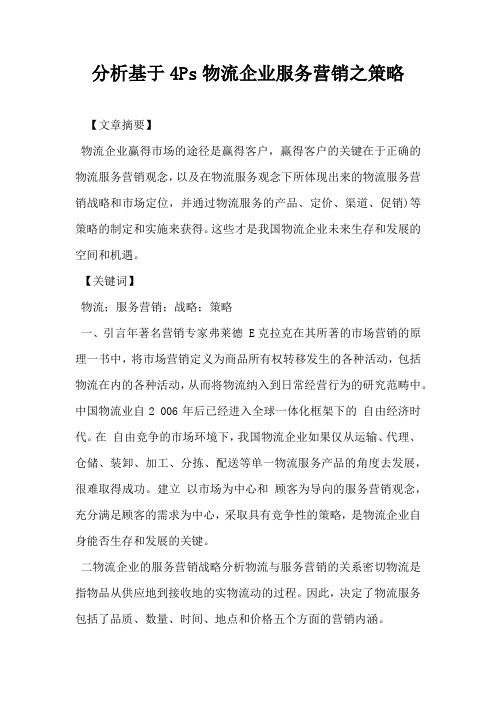
分析基于4Ps物流企业服务营销之策略【文章摘要】物流企业赢得市场的途径是赢得客户,赢得客户的关键在于正确的物流服务营销观念,以及在物流服务观念下所体现出来的物流服务营销战略和市场定位,并通过物流服务的产品、定价、渠道、促销)等策略的制定和实施来获得。
这些才是我国物流企业未来生存和发展的空间和机遇。
【关键词】物流;服务营销;战略;策略一、引言年著名营销专家弗莱德 E克拉克在其所著的市场营销的原理一书中,将市场营销定义为商品所有权转移发生的各种活动,包括物流在内的各种活动,从而将物流纳入到日常经营行为的研究范畴中。
中国物流业自2 006年后已经进入全球一体化框架下的自由经济时代。
在自由竞争的市场环境下,我国物流企业如果仅从运输、代理、仓储、装卸、加工、分拣、配送等单一物流服务产品的角度去发展,很难取得成功。
建立以市场为中心和顾客为导向的服务营销观念,充分满足顾客的需求为中心,采取具有竞争性的策略,是物流企业自身能否生存和发展的关键。
二物流企业的服务营销战略分析物流与服务营销的关系密切物流是指物品从供应地到接收地的实物流动的过程。
因此,决定了物流服务包括了品质、数量、时间、地点和价格五个方面的营销内涵。
在实践中,物流缩短了生产商与顾客的时间距离和空间距离,加快交易,增加交易价值。
因此,物流与服务营销的关系密切,不是单独存在的,它与服务营销的关系密不可分。
福建交通职业技术学院物流企业服务营销战略分析、物流企业服务营销策略的制定和实施,首先取决于企业战略和市场定位。
物流服务战略分析营销理论认为,企业的战略受制于其所处的宏观和微观环境。
物流企业制定服务战略时,一方面,必须考虑企业所在地的宏微观经济环境、政治法律环境、科技与自然环境、社会文化环境,另一方面,更要着重进行企业微观环境分析,辨别在竞争中的优势和劣势,创造和获得成功的机会,避免或减少可能遇到的风险。
有必要运用迈克尔波特五力分析法、SW0T分析法和波士顿矩阵分析法进行分析。
基于4P理论的欧莱雅集团中国市场营销策略研究

眼,吸引用户眼球。
企业要提高消费者对市场的引导作用,将消费者购买欲望作为营销模式创新,企业在设计营销策略时期,要尽可能地注意未来市场,开发新的用户群体,待到用户数量提高到一定程度后,企业会获得更为广阔的上升空间。
为确保营销工作得以正常推进,企业在创新模式过程中,要更为重视市场与企业本身的特性,创新不可盲目选择方向。
健全营销机制很有必要,企业需在内部组建专门负责市场营销的岗位,设置相应的绩效考核标准,指导职工迅速投入到市场营销战略当中,企业可提供更多的机会给实习的大学生,因为这部分群体对工作通常有很多的想法,思维未被束缚,较为活跃、乐于创新、想法新颖。
若企业存在不合理的营销行为,相关部门要积极予以处理。
创新营销战略,需要学习同类企业的成功经验,企业之间不仅有竞争关系,同时也有合作关系,不断完善市场营销机制,为市场营销战略创新奠定基础。
8.适度拓宽营销渠道营销渠道是落实营销策略的重要方式,在网络加持下,多数企业都具有属于自己的营销方式,若想获得较强的竞争力,形成不可取代的地位,需开发出非常规的营销方案。
比如,企业能够按照自身需要开通微信营销渠道,微信营销具有很强的扩散优势,并且用户较多,使用时间长,大部分信息都能得到很好的转发,并且营销成本不高,不需要很高专业素养的人才便能落实,若企业的资金有限,此方法是非常适用的。
微信营销的优势在于能够融合微信支付,人们在日常生活经常用到微信支付,若企业可以在微信上提供会员服务和优惠券,并将此当做基础开展营销,会大幅度增加用户群体。
还能够借助微博开展市场营销,微博用户普遍较为年轻,购买力与消费欲望较强,微博热搜涵盖了国内外的主要新闻,具有较强的娱乐性,用户黏性较强。
企业若开拓了微博的市场营销渠道,博文也是一种很好的品牌传播途径,推广过程更加自然,营销效果更佳,也可开通短视频账号,利用自身流量进行宣传。
新经济背景下的营销战略不只是产品销售,其真正包含的内容非常多,企业要更好地适应现代社会的技术特性,尽可能与互联网相融合,充分考虑外界因素,培养优秀营销团队、强化营销思路,做好市场调研,找准营销战略切入点。
浅析市场营销4p理论策略的论文

浅析市场营销4p理论策略的论文中文意思为,产品,价格,渠道,促销。
企业通过4P理论中各要素的调整与组合,到达满足市场以获取最大利润。
下面是给大家推荐的浅析市场营销4p理论的论文,希望大家喜欢!浅析市场营销4p理论的论文篇一《基于市场营销4P理论的保险营销策略》[提要] 目前,保险业在我国发展非常迅速,为进一步做好保险营销工作,本文结合营销4P理论,对如何做好保险营销工作进行研讨。
关键词:4P;保险;营销策略原标题:基于市场营销4P理论的保险营销策略探讨收录日期:2014年3月9日近几年,我国的保险业市场发展非常迅速,人们对保险的认识和看法也发生了很大的改变,保险日益成为我们生活中不可或缺的一部分。
但我们也要看到,在保险业快速发展壮大的今天,也出现了许多亟待解决的问题,随着市场竞争的进一步加剧,市场对保险公司以及保险从业人员提出了更高的要求,这就需要我们树立正确的营销观念,以4P理论为导向,不断改进我们的营销方式、营销方法,促进整个行业健康发展,增强企业市场竞争力。
4P理论产生于20世纪六十年代的美国,随着营销组合理论的提出而出现的。
其意是指市场需求或多或少的在某种程度上受到所谓“营销变量或“营销要素的影响。
一、保险营销中的产品策略在4P理论中,产品处于基础性地位,也是消费者最为关心的内容,具体到保险业市场,保险产品在本质上是一种避害商品,在投资者买卖股票和债券等金融商品时,他们是以承担一定的风险作为代价,以期待获取更大的收益的。
目前,我国保险市场上的产品存在以下比较突出的问题:1、险种单一,同质化趋势比较严重。
比如,在现阶段,各公司开发的各种养老保险、医疗保险和学前教育保险、旅游保险等在保险费的标准上,以及顾客受到保障的程度基本上千篇一律,许多公司出于各种目的,对新产品开发的力度不强,许多公司没有自己的核心产品,缺乏市场竞争力。
2、市场调研力度不足,对社会需求什么样的产品不甚清楚。
目前,保险公司受到多种因素的影响,关注于竞争者的力度往往还超过了对顾客的关注度。
基于4Ps理论研究丰田公司在中国的营销战略

关键 词 :丰 田汽 车
营销 战略
4 s理论 P
1 引 言
丰 田汽车 公 司于 20 08年 全 球 汽车销 量为 87万辆 ,高 于通 用汽 9 车的 80万销量 ,这 是丰 田公 司首 4 次超越 通用 汽车 公司成 为全球 汽车 销量 的 冠 军 。进 入 2 0 0 9年 ,丰 田 汽车 公司却遭 遇 了历 史上最大 规模
“ 产品、价格 、渠道 、促销 ”则是
营 销 策 略 和 手 段 。4 s R C 、4 s只 能
看 作 是 4 s在 观 念 上 的 完 善 和 创 P 新 。具 体而 言 , P 4 s与 后 两 者是 方
表 3 一 汽 丰 田和 广 汽 丰 田产 品组 合 广 度 和 产 品 线 深 度
消 费 者 ( o sme) C nu r 成 本 ( ot C s) 便 利 ( ovnec ) C neine 沟 通 ( o mu i tn C m nc i ) ao
创新 营销理论 ( R ) 4 s
关 联 ( eeac ) R lvn y 反 映 ( epn ) R sod 关 系 ( eao ) Rli tn 回报 ( eun R tr)
汽车 市 场 上 形 成 了 很 大 的 竞 争 优 势 。2 0 0 7年 以 来 ,在 丰 田 汽 车 公
跑全球 的汽车 市场 。
2 纪 8 代 ,由于丰 田汽 0世 0年
车公 司把主 要 的精 力放 在了 北美市
场,忽略 了与 中 国汽车企 业的合 作 ,使得丰田汽车公司与中国汽车 企业合作进行整车生产的时间晚于 德国的大 众和 美国的通 用。进 入 2 1世纪 ,随 着 中 国 汽 车 市 场 的兴
销理 念和 理 想 的 营销 标 准 ,而 4 s P
4p市场营销理论论文范文

4p市场营销理论论文范文按照经典的市场营销中的4P理论,其发展策略应用对企业的发展起着举足轻重的作用。
下面是店铺为大家推荐的4p营销理论论文,供大家参考。
4p营销理论论文篇一:《凤阳启航考研机构营销分析》一,启航考研机构简介:启航教育的前身是1998年成立的北京启航考试学校。
办学11年来,启航以其不懈的努力和不断的追求,成就了其在考研培训行业中的崇高地位。
如今的启航,已经成长成为以研究生考试教育培训为核心,拥有短期考研培训系统、职业教育系统、咨询服务系统、发展研究系统等多个发展平台,是一家将普研教育与高端教育相结合,研究生教育与职业教育相结合,国内教育与国际教育相结合,教育培训与人生职业规划相结合,集教育培训、教育产品研发、教育服务等于一体的,大型综合性教育培训机构目前安徽科技学院有多家考研教育机构其中包括海文考研,海天考研,文登考研,学府考研,启航考研,在这些考研机构中,经过我的调查,其实力相当,在过去都有过辉煌的历史,比如08级学生有许多都报了海天考研机构,09级学生报学府考研机构的较多,10级的情况目前据我了解报启航考研机构的显著地高于其他考研机构。
风水轮流转,但为什么今年在众多考研机构中启航却以绝对的优势抢的一碗羹呢,这是有诸多原因的,特别是启航在安徽科技学院市场分析中做得比其他考研机构优越。
二,启航考研机构营销策略的4P分析1产品策略(Product):启航考研在全国范围内推出了许多不同的产品,主要包括以下几个产品:(一)龙腾计划(高端辅导)经营理念:启航考研龙腾计划,以职业发展为导向,深度挖掘比较优势,在纵横比较中,精心锻造出绝对优势,使自己在某些方面具备可以傲视同侪的实力,启航教育认为,每个人都有属于自己的“比较优势”。
只不过,并非每个人都能准确地看到自己的优势。
所以,有的人盲目自卑,有的人避实就虚。
看清楚自己,扬长避短,选择合适的目标和方向,是考研和人生路上的第一步。
然而,仅仅发掘“比较优势”还不够。
4ps营销策略组合

4ps营销策略组合4Ps营销策略组合是指产品、价格、渠道和推广的四个方面综合运用,以实现企业销售目标和市场竞争优势。
以下是一个700字的关于4Ps营销策略组合的文章:在现代市场竞争激烈的环境下,企业需要寻找有效的营销策略来吸引消费者,提高销售额,并取得市场竞争优势。
其中,4Ps营销策略组合被认为是一种有效的方法,它由产品、价格、渠道和推广四个方面组成,下面我们将深入探讨其综合运用以实现企业目标的重要性。
首先,产品是4Ps营销策略组合的核心。
产品不仅仅是企业提供给消费者的商品或服务,更是满足消费者需求的工具。
因此,企业需要深入了解消费者的需求,设计和开发出具有独特特点和竞争优势的产品。
这可以通过市场研究和消费者反馈等方式来实现。
在设计产品时,还需要考虑到产品的功能、质量、外观和包装等因素,以满足消费者对产品的期望和喜好。
其次,价格是4Ps营销策略组合中的一项重要策略。
价格直接影响到消费者购买决策的过程,因此,企业需要根据产品的定位、目标市场和竞争对手的价格水平来制定合理的价格策略。
如果企业经营的是高品质和高附加值的产品,那么可以采用高价策略来体现产品的独特价值;如果企业的产品定位是中低端市场,那么可以采用低价策略来吸引消费者。
此外,企业还可以通过优惠活动、折扣和捆绑销售等方式来提高产品的竞争力。
第三,渠道是4Ps营销策略组合中的另一个关键要素。
渠道选择有助于产品的分销和宣传,进而实现销售目标。
企业可以选择直接渠道,如自有门店和电子商务平台,也可以选择间接渠道,如经销商和代理商。
选择适合业务发展的渠道可以帮助企业降低成本、提高效率,并扩大市场覆盖范围。
此外,渠道管理也需要确保产品能够正常流通,满足消费者的需求,以及处理退货和售后服务等问题。
最后,推广是4Ps营销策略组合的重要组成部分。
推广包括广告、公关、销售促销和个人销售等形式,可以帮助企业宣传产品、吸引消费者和促进销售。
企业需要选择适合目标市场和消费者的推广方式,并制定相应的推广计划。
基于4P理论的企业营销策略分析——以宋城演艺为例
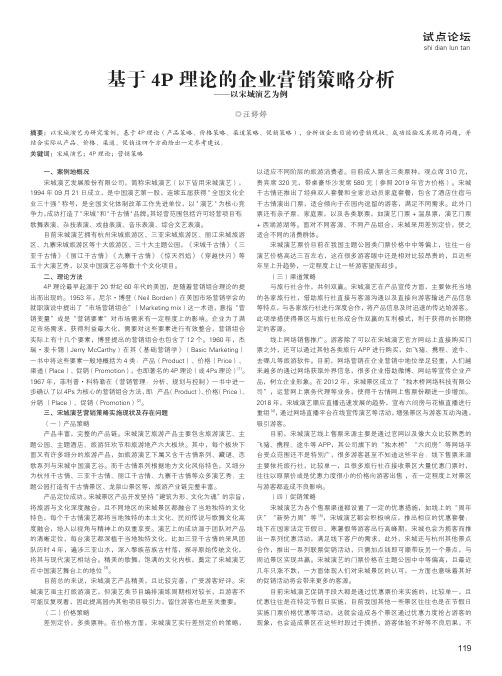
试点论坛shi dian lun tan119基于4P 理论的企业营销策略分析——以宋城演艺为例◎汪婷婷摘要:以宋城演艺为研究案例,基于4P 理论(产品策略、价格策略、渠道策略、促销策略),分析该企业目前的营销现状、成功经验及其现存问题,并结合实际从产品、价格、渠道、促销这四个方面给出一定参考建议。
关键词:宋城演艺;4P 理论;营销策略一、案例地概况宋城演艺发展股份有限公司,简称宋城演艺(以下皆用宋城演艺),1994年09月21日成立,是中国演艺第一股,连续五届获得"全国文化企业三十强"称号,是全国文化体制改革工作先进单位,以"演艺"为核心竞争力,成功打造了"宋城"和"千古情"品牌。
其经营范围包括许可经营项目有:歌舞表演、杂技表演、戏曲表演、音乐表演、综合文艺表演。
目前宋城演艺拥有杭州宋城旅游区、三亚宋城旅游区、丽江宋城旅游区、九寨宋城旅游区等十大旅游区、三十大主题公园,《宋城千古情》《三亚千古情》《丽江千古情》《九寨千古情》《惊天烈焰》《穿越快闪》等五十大演艺秀,以及中国演艺谷等数十个文化项目。
二、理论方法4P 理论最早起源于20世纪60年代的美国,是随着营销组合理论的提出而出现的。
1953年,尼尔·博登(Neil Borden)在美国市场营销学会的就职演说中提出了“市场营销组合”(Marketing mix)这一术语,意指“营销变量”或是“营销要素”对市场需求有一定程度上的影响。
企业为了满足市场需求,获得利益最大化,需要对这些要素进行有效整合,营销组合实际上有十几个要素,博登提出的营销组合也包含了12个。
1960年,杰瑞·麦卡锡(Jerry McCarthy)在其《基础营销学》(Basic Marketing)一书中将这些要素一般地概括为4类:产品(Product)、价格(Price)、渠道(Place)、促销(Promotion),也即著名的4P 理论(或4Ps 理论)[1]。
基于4Ps理论的照明行业市场营销策略研究——以北京鑫源盛彭电光源有限公司为例
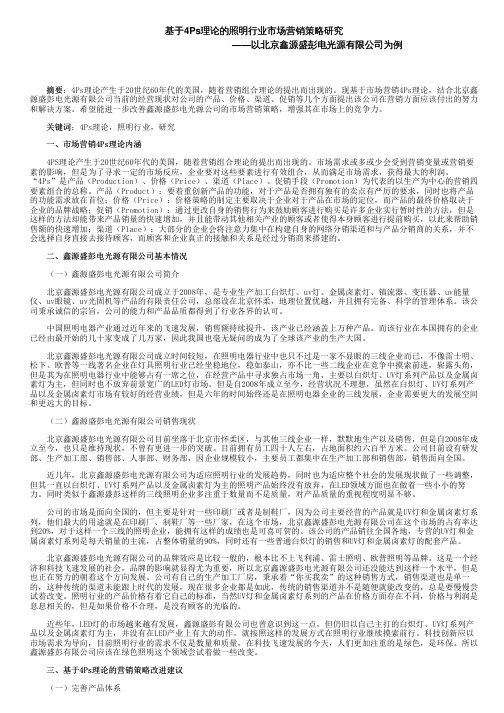
基于4Ps理论的照明行业市场营销策略研究——以北京鑫源盛彭电光源有限公司为例摘要:4Ps理论产生于20世纪60年代的美国,随着营销组合理论的提出而出现的。
现基于市场营销4Ps理论,结合北京鑫源盛彭电光源有限公司当前的经营现状对公司的产品、价格、渠道、促销等几个方面提出该公司在营销方面应该付出的努力和解决方案。
希望能进一步改善鑫源盛彭电光源公司的市场营销策略,增强其在市场上的竞争力。
关键词:4Ps理论,照明行业,研究一、市场营销4P s理论内涵4PS理论产生于20世纪60年代的美国,随着营销组合理论的提出而出现的。
市场需求或多或少会受到营销变量或营销要素的影响,但是为了寻求一定的市场反应,企业要对这些要素进行有效组合,从而满足市场需求,获得最大的利润。
“4Ps”是产品(Production)、价格(Price)、渠道(Place)、促销手段(Promotion)为代表的以生产为中心的营销四要素组合的总称。
产品(Product):要着重创新产品的功能,对于产品是否拥有独有的卖点有严厉的要求,同时也将产品的功能需求放在首位;价格(Price):价格策略的制定主要取决于企业对于产品在市场的定位,而产品的最终价格取决于企业的品牌战略;促销(Promotion):通过更改自身的销售行为来鼓励顾客进行购买是许多企业实行暂时性的方法,但是这样的方法却能带来产品销量的快速增加,并且能带动其他相关产业的顾客或者使得本身顾客进行提前购买,以此来帮助销售额的快速增加;渠道(Place):大部分的企业会将注意力集中在构建自身的网络分销渠道和与产品分销商的关系,并不会选择自身直接去接待顾客,而顾客和企业真正的接触和关系是经过分销商来搭建的。
二、鑫源盛彭电光源有限公司基本情况(一)鑫源盛彭电光源有限公司简介北京鑫源盛彭电光源有限公司成立于2008年,是专业生产加工白炽灯、uv灯、金属卤素灯、镇流器、变压器、uv能量仪、uv眼镜、uv光固机等产品的有限责任公司,总部设在北京怀柔,地理位置优越,并且拥有完备、科学的管理体系。
- 1、下载文档前请自行甄别文档内容的完整性,平台不提供额外的编辑、内容补充、找答案等附加服务。
- 2、"仅部分预览"的文档,不可在线预览部分如存在完整性等问题,可反馈申请退款(可完整预览的文档不适用该条件!)。
- 3、如文档侵犯您的权益,请联系客服反馈,我们会尽快为您处理(人工客服工作时间:9:00-18:30)。
论基于4ps理论的A公司市场营销策略-毕业
论文
.wenwendata.
摘要
市场营销策略对于提高企业营销素质,增强企业活力和竞争力,在激烈的市场竞争取胜具有重要作用。
市场营销理论主要研究市场营销活动及其规律性,是建立在经济科学、行为科学、现代管理理论基础之上,也是适应现代商品经济高速发展而产生和发展起来的一门关于企业经营管理决策的科学。
本文以山东A公司为案例,运用“4Ps”营销理论的基本思路,从产品设计、产品定价、渠道策略、促销策略等方面分析了该公司进一步发展的方向,并且提出了策略实施的具体保障,对该公司的发展具有参考意义。
关键词:市场营销 A公司 4Ps营销理论
.wenwendata.
目录
一、4Ps营销理论的内
涵 .............................................. 3 二、山东A公司的概况介绍.. (3)
(一)公司的发展历
史 ............................................ 3 (二)公司的经营状
况 ............................................ 4 三、山东A公司的swot分析. (4)
(一)优
势 ......................................................
4 (二)劣
势 ......................................................
5 (三)机
会 ......................................................
5 (四)挑
战 ......................................................
5 四、山东A公司市场营销策略的优化 (6)
(一)产品策
略 (6)
(二)价格策
略 (6)
(三)渠道策
略 (7)
(四)促销策
略 (7)
结语....................................................... ......... 8 参考文献....................................................... .. (9)
.wenwendata.
随着社会经济的发展,消费需求的差别市场正在朝向特色化方向发展。
企业采用符合自身特点的特色化市场营销策略可以提供与众不同的产品和服务,形成企业的竞争优势。
企业应该捕捉到市场的细微变化,了解市场的走势,通过对市场信息的深刻理解和快速反应,把握住市场定位,采用有效的市场营销策略,使企业在新的市场环境中不断发展。
一、4Ps营销理论的内涵
菲利普?科特勒于1967年在其畅销书《营销管理:分析、规划与控制》中进一步明确了以4Ps为核心的营销组合方法,具体包括:第一,产品(Product):注重开发的功能,把产品的功能诉求放在第一位,主张产品应该有独特的卖点。
第二,价格(Price):根据不同的市场定位制定适应的价格策略,企业的品牌战略是产品的定价依据,注重品牌的含金量。
第三,分销(Place):注重经销商的培育和销售网络的建立,企业与消费者不
存在直接联系,而是通过分销商来进行的。
第四,促销(Promotion):注重销售行为的改变来刺激消费,以短期的行为(如打折等)促成消费的增长,吸引消费者或导致提前消费来促进销售的增长。
二、山东A公司的概况介绍
(一)公司的发展历史
山东富豪菲格尔皮具有限公司(以下简称A公司)是国内专业生产皮具箱包的大型企业之一,拥有职工1500多人,各种专业设计人才100多人。
1996年3月由皮件、鞋等5个传统企业组建成山东富豪集团公司(其中最早的皮件厂1958年建厂)。
20xx年1月改制为私有股份制企业并更名为:山东富豪菲格尔皮具有限公司。
十几年以来,该公司以“FEGLAR”菲格尔品牌箱包皮具为主导产品,在国际市场取得成功以后,近几年又在国内市场创造了很好的业绩。
现已发展成为中国箱包皮具行业最具规模、潜力的企业之一。
其位于乳山城区的“富豪工业园”占地面积12万多平方米,建筑面积67000平方米,是一座集生产、办公、。
